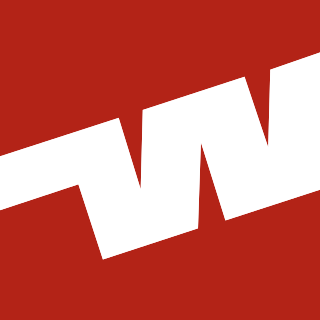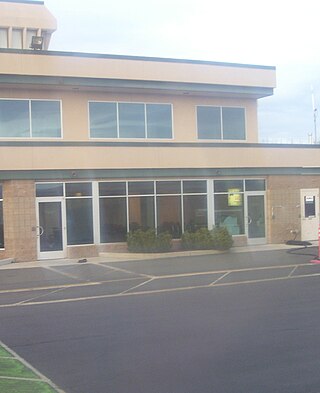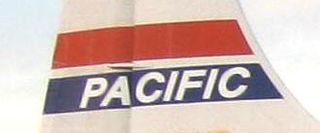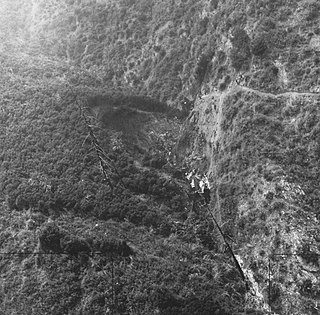
Western Airlines was a major airline in the United States based in California, operating in the Western United States including Alaska and Hawaii, and western Canada, as well as to New York City, Boston, Washington, D.C., and Miami and to Mexico City, London and Nassau. Western had hubs at Los Angeles International Airport, Salt Lake City International Airport, and the former Stapleton International Airport in Denver. Before it merged with Delta Air Lines in 1987 it was headquartered at Los Angeles International Airport (LAX). Throughout the company's history, its slogan was "Western Airlines...The Only Way to Fly!"

Eugene Airport, also known as Mahlon Sweet Field, is a public airport 7 miles (11 km) northwest of Eugene, in Lane County, Oregon, United States. Owned and operated by the City of Eugene, it is the fifth-largest airport in the Pacific Northwest.

Boise Airport is a joint civil-military airport in the western United States in Idaho, three miles (5 km) south of downtown Boise in Ada County. The airport is operated by the city of Boise Department of Aviation, overseen by an airport commission. The busiest airport in the state, it serves more passengers than all other Idaho airports combined and roughly ten times as many passengers as the next busiest airport at Idaho Falls.
Pacific Southwest Airlines (PSA) was a low-cost US airline headquartered in San Diego, California, that operated from 1949 to 1988. It was the first substantial scheduled discount airline. PSA called itself "The World's Friendliest Airline" and painted a smile on the nose of its airplanes, the PSA Grinningbirds. Opinion L.A. of the Los Angeles Times called PSA "practically the unofficial flag carrier airline of California for almost forty years."

King County International Airport, commonly Boeing Field, is a public airport owned and operated by King County, five miles south of downtown Seattle, Washington. The airport is sometimes referred to as KCIA, but it is not the airport identifier. The airport has scheduled passenger service operated by Kenmore Air, a commuter air carrier, and was being served by JSX with regional jet flights. It is also a hub for UPS Airlines. It is also used by other cargo airlines and general aviation aircraft. The airfield is named for founder of Boeing, William E. Boeing, and was constructed in 1928, serving as the city's primary airport until the opening of Seattle–Tacoma International Airport in 1944. The airport's property is mostly in Seattle just south of Georgetown, with its southern tip extending into Tukwila. The airport covers 634 acres (257 ha), averages more than 180,000 operations annually, and has approximately 380 based aircraft.

Imperial County Airport is a county-owned public-use airport in Imperial County, California, United States. Also known as Boley Field, it is mostly used for general aviation, but has scheduled passenger service from one commercial airline. Service is subsidized by the Essential Air Service program.

Idaho Falls Regional Airport is two miles north-northwest of downtown Idaho Falls, Idaho, United States. It is locally known as Fanning Field. It is the second-busiest airport in Idaho after Boise Airport.

Lewiston–Nez Perce County Airport is a public airport in the northwest United States, in north-central Idaho. Owned by the city of Lewiston and Nez Perce County, it is in an elevated area of the city two miles (3 km) south of downtown, approximately 700 vertical feet (210 m) above the Snake and Clearwater rivers.

Friedman Memorial Airport is a city-owned public-use airport in the northwest United States, located one nautical mile (2 km) southeast of the central business district of Hailey, the county seat of Blaine County, Idaho. The airport is operated by the Friedman Memorial Airport Authority under a joint powers agreement between the city of Hailey and Blaine County. It serves the resort communities of Sun Valley and Ketchum, and the surrounding areas in the Wood River Valley.

Magic Valley Regional Airport, also known as Joslin Field, is a public use airport located four nautical miles (7 km) south of the central business district of Twin Falls, Idaho. The airport is owned by the City and County of Twin Falls. It is mostly used for general aviation but is also served by one commercial airline.

McAllister Field is a public airport three miles south of Yakima, in Yakima County, Washington. Owned by the City of Yakima, it is used for general aviation and commercial air service. Yakima is served by one scheduled passenger air carrier and two non-scheduled carriers. Sun Country Airlines operates charter flights to Laughlin, NV and Xtra Airways operates charter flights to Wendover, NV.
Frontier Airlines was an airline in the United States formed by a merger of Arizona Airways, Challenger Airlines, and Monarch Airlines on June 1, 1950. Headquartered at the now-closed Stapleton International Airport in Denver, Colorado, the airline ceased operations on August 24, 1986. A new airline using the same name was founded eight years later in 1994.

Pacific Air Lines was a regional airline on the West Coast of the United States that began scheduled passenger flights in the mid-1940s under the name Southwest Airways. The company linked small cities in California with larger cities such as Los Angeles and San Francisco. Flights later operated to Portland, Oregon, and eventually reached Las Vegas and Reno in Nevada.

Bonanza Air Lines was an airline in the Western United States from 1945 until it merged with two other local service airlines to form Air West in 1968. Its headquarters was initially Las Vegas, Nevada, and moved to Phoenix, Arizona in 1966.
West Coast Airlines was an airline linking small cities in the Pacific Northwest with larger cities in Washington, Oregon, Idaho, Utah, Montana, California and north to Alberta in Canada. It was headquartered in the Westlake area of Seattle, Washington.
Republic Airlines was an airline from 1979 to 1986 in the United States, which was merged with Northwest Airlines. Republic was formed by the merger of North Central Airlines and Southern Airways on July 1, 1979. Their headquarters were at Minneapolis-St. Paul International Airport, in what is now Fort Snelling in unincorporated Hennepin County, Minnesota. The former headquarters is now Delta Air Lines Building C.

Hughes Airwest Flight 706 was a regularly scheduled flight operated by American domestic airline Hughes Airwest from Los Angeles, California to Seattle, Washington, with several intermediate stops. On Sunday, June 6, 1971, the McDonnell Douglas DC-9 serving as Flight 706 departed Los Angeles just after 6 p.m. en route to Seattle as a McDonnell Douglas F-4 Phantom II of the United States Marine Corps was approaching Marine Corps Air Station El Toro near Irvine at the end of a flight from Naval Air Station Fallon in Nevada. The two aircraft collided in midair over the San Gabriel Mountains near Duarte, killing all 49 aboard the DC-9 and the F-4 pilot; the F-4 radar intercept officer ejected and survived.

North Central Airlines was a regional airline in the Midwestern United States. Founded as Wisconsin Central Airlines in 1944 in Clintonville, Wisconsin, the company moved to Madison in 1947. This is also when the "Herman the duck" logo was born on Wisconsin Central's first Lockheed Electra 10A, NC14262, in 1948. North Central's headquarters were moved to Minneapolis–St. Paul in 1952.
Key Airlines was founded as Thunderbird Airlines in 1964 and then changed its name in 1969. The airline took over Sun Valley Airlines in 1972 and became known as Sun Valley Key Airlines for several years until reverting to the Key Airlines name. The airline began as a commuter and charter air carrier in the western United States flying turboprop and prop aircraft. In later years, Key Airlines operated a hub in Savannah, Georgia with scheduled passenger flights operated with mainline jet aircraft to international and domestic destinations.

Mountain West Airlines-Idaho was a short-lived commuter airline based in Boise, Idaho. Its motto was "Nobody knows the Mountain West like we do!"

















